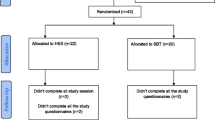Abstract
PURPOSE: This study was designed to compare prospectively the effects of augmented biofeedback with those of sensory biofeedback alone on fecal incontinence and anorectal manometry after obstetric trauma. METHODS: A consecutive cohort of 40 females with impaired fecal continence after obstetric anal sphincter injury were recruited from a dedicated perineal clinic. Patients were randomly assigned to receive either augmented biofeedback or sensory biofeedback alone. All patients were assessed before and after twelve weeks of biofeedback training, using a fecal continence questionnaire and anorectal manometry. RESULTS: Thirty-nine of 40 females recruited completed the study. Continence scores improved in both treatment groups, but the results were better for those who received augmented biofeedback. Anorectal manometry was unchanged by sensory biofeedback, whereas anal resting and squeeze pressures increased with augmented biofeedback. No change in anal vector symmetry was observed in either group. CONCLUSION: Augmented biofeedback training is superior to sensory biofeedback alone in the treatment of impaired fecal continence after obstetric trauma.
Similar content being viewed by others
References
Swash M. Fecal incontinence: childbirth is responsible for most cases. BMJ 1993;307:636–7.
Donnelly V, Fynes M, Campbell D, Johnson H, O'Connell PR, O'Herlihy C. Obstetric events leading to anal sphincter damage. Obstetrics and Gynecology 1998;92:955–61.
Snooks SJ, Swash M, Setchell M, Henry MM. Injury to innervation of pelvic floor sphincter musculature in childbirth. Lancet 1984;2:546–50.
Kegel AH. Physiologic therapy for urinary stress incontinence. JAMA 1951;146:915–7.
Kegel AH. Stress incontinence of urine in women. J Int Coll Surg 1956;25:487–99.
Berghmans LC, Frederiks CM, De Bie RA,et al. Efficacy of biofeedback when included with pelvic floor muscle exercise treatment for genuine stress incontinence. Neurourol Urodyn 1996;15:37–52.
Enck P. Biofeedback training in disordered defecation: a critical review. Dig Dis Sci 1993;11:1953–60.
Perry RE, Blatchford GJ, Christensen MA, Thorson AG, Attwood SE. Manometric diagnosis of anal sphincter injuries. Am J Surg 1990;159:112–7.
Snooks JJ, Swash M. Nerve stimulation techniques. In: Henry M, Swash M, eds. Coloproctology and the pelvic floor. London: Butterworths, 1985:112–28.
Law PJ, Kamm MA, Bartram CI. Anal endosonography in the investigation of fecal incontinence. Br J Surg 1991;78:312–4.
Kernell D, Eerbeek O, Verley BA, Donselaar Y. Effects of physiologic amounts of high and low rate chronic stimulation of fast twitch muscle of the cat hind limb: speed and force related properties. J Neurophysiol 1987;58:598–613.
Pescatori M, Anastasio G, Bottini C, Mentasti A. New grading and scoring for anal incontinence: evaluation of 335 patients. Dis Colon Rectum 1992;35:482–7.
Jones DA, Bigland-Richie B, Edwards RH. Excitation frequency and muscle fatigue mechanical responses during voluntary and stimulated contraction. Exp Neurol 1979;64:401–13.
Basmajian JV. Motor control disorders. Phys Med Rehab Clin 1993;4:745–63.
Bump RC, Glenn Hurt W, Fantl JL, Wymann JF. Assessment of Kegel pelvic muscle exercise performance after brief verbal instruction. Am J Obstet Gynecol 1991;165:322–9.
Eklund G. Position sense and state of contraction: the effects of vibration. J Neurol Neurosurg Psych 1972;35:606–11.
Collins CD, Duthie HL, Shelley T, Whittaker GE. Force in the anal canal and anal continence. Gut 1967;8:354–60.
Eccles JC, Eccles RM, Lundberg A. The action potentials of alpha motor neurons supplying fast and slow muscle fibres. J Physiol 1958;142:275–91.
Henneman E, Clayman NP, Gillies JD, Skinner RD. Rank order of motor neurons with a pool: law of combination. J Physiol 1974;37:1338–49.
Debacher GA. Experimental techniques in human neuropsychology. In: Hannay S. ed. Electromyography. New York: Oxford University Press, 1986:115–65.
Adrian ED, Bronk DW. The discharge of impulses in motor nerve fibres: the frequency of discharge in reflex and voluntary contraction. J Physiol 1929;67:119–51.
Brown GL, Burns BD. Fatigue and neuromuscular block in mammalian skeletal muscle. J R Soc Med 1949;136:182–95.
Keighley MR, Fielding JW. Management of fecal incontinence and results of surgical treatment. Br J Surg 1983;70:463–8.
Author information
Authors and Affiliations
Additional information
This study was funded by the Irish Health Research Board, the Mater College for Education and Research, and the Friends of the Rotunda Hospital, Dublin, Ireland.
About this article
Cite this article
Fynes, M.M., Marshall, K., Cassidy, M. et al. A prospective, randomized study comparing the effect of augmented biofeedback with sensory biofeedback alone on fecal incontinence after obstetric trauma. Dis Colon Rectum 42, 753–758 (1999). https://doi.org/10.1007/BF02236930
Issue Date:
DOI: https://doi.org/10.1007/BF02236930




